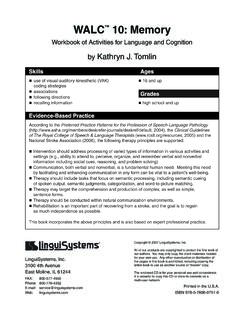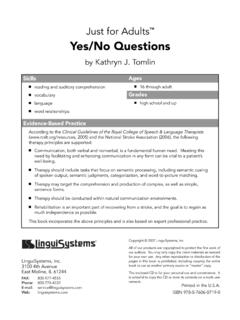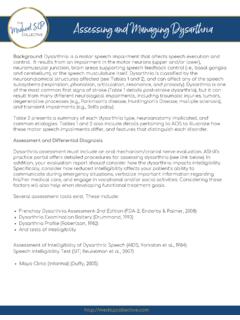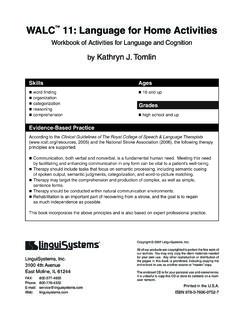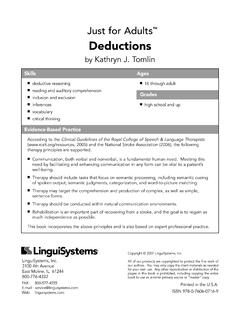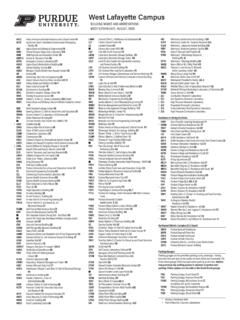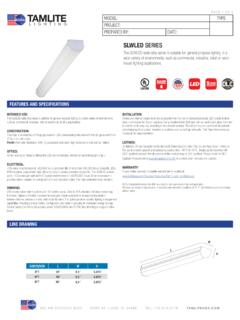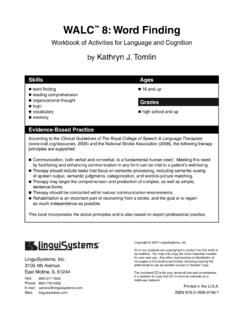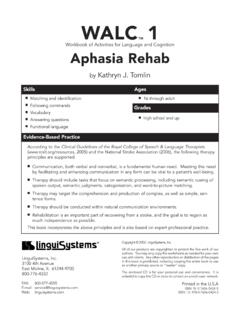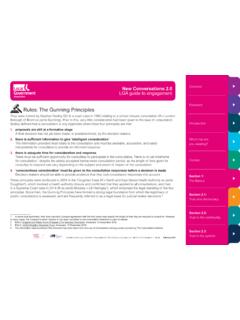Transcription of WALC 9: Verbal and Visual Reasoning - Therapists for Armenia
1 WALC 9: Verbal and Visual Reasoning Workbook of Activities for Language and Cognition by Kathryn J. Tomlin Skills Ages Verbal and Visual Reasoning 16 and up thought organization convergent Reasoning logic Grades insight high school and up integration inferencing Visual perception Evidence-Based Practice According to the Clinical Guidelines of The Royal College of Speech & Language Therapists ( , 2005) and the National Stroke Association (2006), the following therapy principles are supported: Communication, both Verbal and nonverbal, is a fundamental human need. Meeting this need by facilitating and enhancing communication in any form can be vital to a patient's well-being. Therapy should include tasks that focus on semantic processing, including semantic cueing of spoken output, semantic judgments, categorization, and word-to-picture matching.
2 Therapy may target the comprehension and production of complex, as well as simple, sentence forms. Therapy should be conducted within natural communication environments. Rehabilitation is an important part of recovering from a stroke, and the goal is to regain as much independence as possible. This book incorporates the above principles and is also based on expert professional practice. Copyright 2007 LinguiSystems, Inc. All of our products are copyrighted to protect the fine work of our authors. You may only copy the client materials needed for your own use. Any other reproduction or distribution of LinguiSystems, Inc. the pages in this book is prohibited, including copying the 3100 4th Avenue entire book to use as another source or master copy. East Moline, IL 61244 The enclosed CD is for your personal use and convenience.
3 It is unlawful to copy this CD or store its contents on a FAX: 800-577-4555 multi-user network. Phone: 800-776-4332. E-mail: Printed in the Web: ISBN 978-0-7606-0750-3. About the Author Kathryn J. Tomlin, , CCC-SLP, has been a speech-language pathologist in hospitals, rehabilitation centers, and long-term care facilities for over 25 years. Her materials, developed while working with clients, have evolved over the years. She has authored many materials with LinguiSystems over the last 20 years. Some of her works include: The Source for Apraxia Therapy WALC (Workbook of Activities for Language and Cognition) Series . WALC 1: Aphasia Rehab (English and Spanish versions). WALC 2: Cognitive Rehab (English and Spanish versions). WALC 8: Word Finding WALC 10: Memory Kathy and her therapy dog, Zanmi WALC 11: Language for Home Activities Zanmi, Kathy's Samoyed, goes to work with her to encourage clients.
4 Her clients enjoy feeding and spending time with Zanmi, and Zanmi enjoys their company. Everybody wins! Dedication This book is dedicated to the Peanut Gallery at Liberty Nursing & Rehabilitation Center: Kathy Kattner, Hollie Gower, Alison Parker, Lois Steward, Dawn Villanova, Lisa Yerger, Jennifer Klembara, Liz Buresh, Kim Sturm, and Gail Combs. I am most grateful for your input on these exercises and during my therapy sessions. Believe it or not, I am listening to your input more than I will ever let you know. You're the best! Edited by Lauri Whiskeyman Cover Design by Jason Platt Illustrations by Margaret Warner Page Layout by Lisa Parker Table of Contents Introduction .. 7. Verbal Reasoning .. 10. Emotions and Personal Situations .. 10. Emotions Describing Situations.
5 11. Situations Labeling Emotions .. 12. Consequences .. 13. Causes .. 14. Problem Solving Missing Equipment .. 15. Opinions .. 17. Self-Concept .. 18. Self-Analysis .. 19. Family Interaction .. 20. Wishes .. 21. Employment Analysis .. 22. Friendship .. 23. The Perfect Day .. 24. Ten Enjoyable Activities .. 25. Activity Goals .. 26. Conversation Skills .. 27. Idioms and Proverbs .. 36. Expression Completion and Explanation .. 37. Missing Letters .. 39. Mixed-Up Expressions .. 40. Expression Interpretation Literal and Abstract .. 41. Matching Proverbs to Situations .. 44. Categorization .. 45. Naming Objects by Attributes .. 46. Description One Object .. 49. Description and Comparison Two Objects .. 51. Which Does Not Belong? .. 53. General Category Labeling.
6 55. Subcategory Labeling .. 56. Specific Member Labeling .. 57. Categorization Grid .. 58. Categorization in Sentences .. 60. WALC 9: Verbal and Visual Reasoning 3 Copyright 2007 LinguiSystems, Inc. Table of Contents, continued Convergent Reasoning .. 61. Fact/Opinion .. 62. Negative True/False Statements .. 64. Sequencing .. 66. Increasing Word Length .. 69. Diagrams with Choices .. 70. Diagrams Without Choices .. 73. Anagrams .. 75. Anagrams in Sentences .. 77. Symbol Substitution .. 79. Change One Letter .. 81. Change One Letter Create .. 83. Numbers and General Information .. 84. Double Meaning Deduction .. 85. Deduction Puzzles .. 87. Roman Numeral Conversion .. 93. Deduction by Exclusion .. 94. Word Search Opposites .. 96. Logic Questions .. 97. Word Wheel.
7 101. Build the Answer .. 102. Combined Associated Words .. 103. Separating .. 105. Numerical Sequences .. 107. Acrostics .. 109. Describe Without Naming .. 111. Advertisements .. 112. Analogies .. 113. Completing Analogies .. 114. Analogies Complete the Second Half .. 115. Analogies Complete the First Section .. 118. Paragraph Comprehension .. 120. Story Inferences .. 121. WALC 9: Verbal and Visual Reasoning 4 Copyright 2007 LinguiSystems, Inc. Table of Contents, continued Visual Reasoning .. 124. Visual Analogies .. 124. Picture Analogies .. 125. Figural Analogies One Factor .. 129. Figural Analogies Two Factors .. 132. Figural Analogies Three Factors .. 135. Drawing Analogy Pairs One Factor .. 138. Drawing Analogy Pairs Two Factors .. 140. Visual Figure-Ground.
8 142. Locating Items .. 143. Embedded Shapes .. 146. Visual Sequencing .. 150. Figural Sequences One Factor .. 151. Figural Sequences Two Factors .. 153. Figural Sequences Three Factors .. 155. Figural Sequences Varying Number of Factors .. 156. Connect the Dots Alphabetical .. 158. Connect the Dots Numerical .. 159. Connect the Dots Alternating .. 160. Connect the Dots Integration .. 161. Visual Closure and Reasoning .. 162. Closure .. 163. Mirror Images .. 165. Figural Grid .. 167. Differences Between Pictures .. 169. Picture Inferences .. 173. Picture Incongruities .. 177. Drawing .. 180. Directions Grid .. 181. Draw Figure to Scale .. 182. Floor Plan Sketch .. 183. Resources .. 185. Answer Key .. 187. WALC 9: Verbal and Visual Reasoning 5 Copyright 2007 LinguiSystems, Inc.
9 Introduction Being able to reason with Verbal and Visual information is an integral part of how we communicate, problem solve, make decisions, and achieve success in relationships with others. The tasks in WALC 9: Verbal and Visual Reasoning address multiple levels of Reasoning in a wide variety of exercises. This is to improve your client's ability to reason flexibly and to expand his ability to identify, analyze, and modify information. Having a large repertoire of Verbal and Visual Reasoning abilities will help your client determine the effectiveness of his own responses plus analyze what is being said to him or presented to him in written or graphic form. WALC 9 was written to provide stimulus materials for Verbal and Visual Reasoning when working with clients who are neurologically impaired.
10 The tasks in this book, developed while working with a wide variety of clients, have evolved and have been perfected over the years. The tasks will stimulate your client's ability to reason while tapping into many facets of cognitive-linguistic communication. He will use pre-existing skills ( , previously learned Visual and Verbal content and processes already established in a client's cognitive system) to help him link or associate information as a basis for solving the challenging, integrative tasks. Verbal and Visual Reasoning tasks are the main focus of this book, however many processes are addressed in each task, including the following. Thought Organization Most of the tasks in this book involve organization of thought ( , strategies that require your client to determine a relationship or process and carry that pattern over to successfully complete similar tasks).
